#Oracle Enterprise Data Management Cloud Service
Explore tagged Tumblr posts
Link
SpiritSofts, a leading training institute, offers the Best Oracle EDMCS Online Training. Our comprehensive program covers all aspects of Oracle EDMCS, led by industry experts. Gain hands-on experience in data modeling, metadata management, and data integration. Learn effective change management and collaboration techniques. Elevate your data management skills with SpiritSofts' top-notch training. Enroll now to excel in Oracle EDMCS and unlock new career opportunities.
#https://www.spiritsofts.com/oracle-edmcs-online-training/#Master Oracle Enterprise Data Management Cloud Service (EDMCS) with Top Online Training#Discover how to efficiently manage govern and maintain your organization's critical data assets using the powerful features of Oracle EDMCS.#OracleEDMCS EnterpriseDataManagement DataGovernance DataManagement CloudTraining OnlineLearning DataAnalytics ITProfessional BusinessIntelli
0 notes
Text
2024 team sponsors recap!
this is completely irrelevant to F1 but i study and do these stuffs for a living sooo 😩😩 2023 sponsors are based on the sponsors that are there at the beginning of the season (new sponsors that join in the middle of the season will be classified as 2024's)
Mercedes AMG Petronas F1 Team:
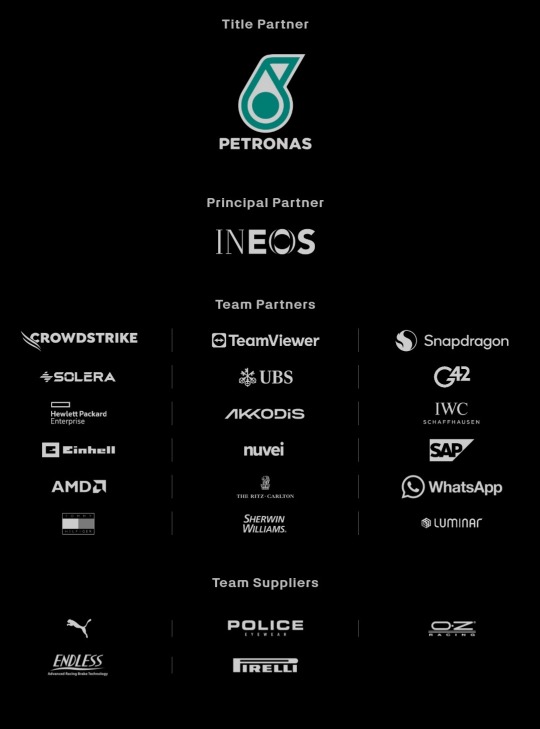
New sponsors: Whatsapp, Luminar (American tech company), SAP (German software company), nuvei (Canadian credit card services), Sherwin Williams (American painting company) 2024 data last update: 2024/02/14
Old sponsors that left: Monster Energy, Pure Storage (American technology company), fastly (American cloud computing services), Axalta (American painting company), Eight sleep (American mattresses company) 2023 data last update: 2023/01/07
Oracle Red Bull Racing F1 Team:
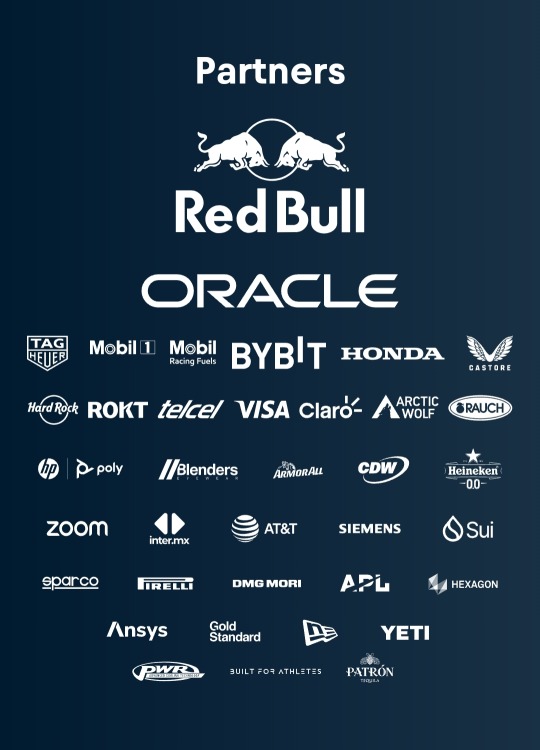
New sponsors: Yeti (American cooler manufacturer, joined later in 2023), APL (American footwear/athletic apparel manufacturer, joined later in 2023), CDW (American IT company, joined later in 2023), Sui (American tech app by Mysten Labs, joined later in 2023), Patron Tequila (Mexican alcoholic beverages company, joined later in 2023) 2024 data last update: 2024/02/15
Old sponsors that left: CashApp, Walmart, Therabody (American wellness technology company), Ocean Bottle (Norwegian reusable bottle manufacturer), PokerStars (Costa Rican gambling site), Alpha Tauri (? no info if they're official partners or not but Austrian clothing company made by Red Bull), BMC (Switzerland bicycle/cycling manufacturer), Esso (American fuel company, subsidiary of ExxonMobil), Hewlett Packard Enterprise (American technology company) 2023 data last update: 2023/03/07
More: Esso is a subsidiary of Mobil so there's possibility they merged or something
Scuderia Ferrari:
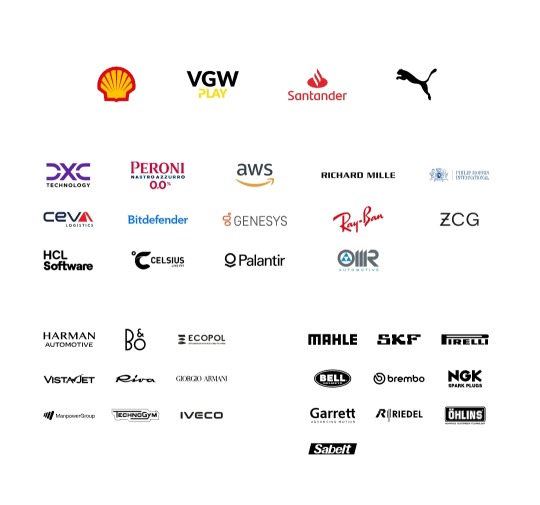
New sponsors: VGW Play (Australian tech game company, joined later in 2023), DXC Technology (American IT company, joined later in 2023), Peroni (Italian brewing company), Z Capital Group/ZCG (American private asset management/merchant bank company), Celsius (Swedish energy drink manufacturer) 2024 data last update: 2024/02/15
Old sponsors that left: Mission Winnow (American content lab by Phillip Morris International aka Marlboro), Estrella Garcia (Spanish alcoholic beverages manufacturer), Frecciarossa (Italian high speed train company) 2023 data last update: 2023/02/16
More: Mission Winnow is a part of Phillip Morris International. They are no longer listed as team sponsor but PMI is listed instead.
(starting here, 2023 data last update is 2023/02/23 and 2024 data last update is 2024/02/15)
McLaren F1 Team: (Only McLaren RACING's data is available idk if some of these are XE/FE team partners but anw..)
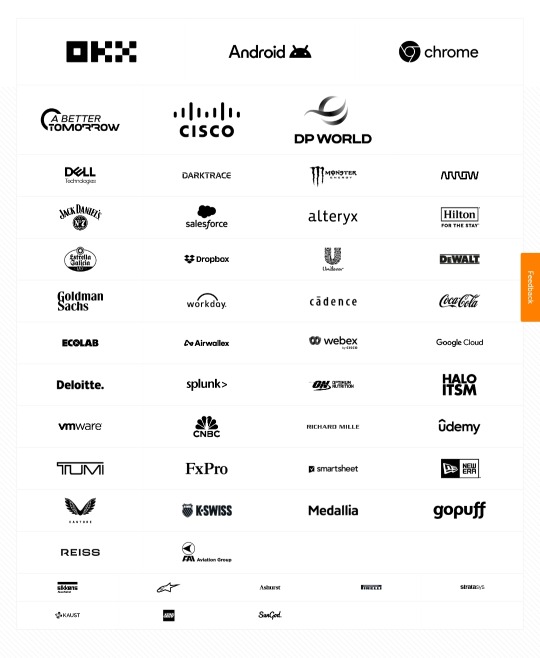
New sponsors: Monster Energy, Salesforce (American cloud based software company, joined later in 2023), Estrella Garcia (Spanish alcoholic beverages manufacturer), Dropbox (American file hosting company), Workday (American system software company, joined later in 2023), Ecolab (American water purification/hygiene company), Airwallex (Australian financial tech company), Optimum Nutrition (American nutritional supplement manufacturer), Halo ITSM (American software company, joined later in 2023), Udemy (American educational tech company, joined later in 2023), New Era (American cap manufacturer, joined in 2023), K-Swiss (American shoes manufacturer, joined later in 2023), Alpinestars (Italian motorsports safety equipment manufacturer)
Old sponsors that left: DP World (Emirati logistics company), EasyPost (American shipping API company), Immersive Labs (UK cybersecurity training company?), Logitech, Mind (UK mental health charity), PartyCasino (UK? online casino site), PartyPoker (American? gambling site), Sparco (Italian auto part & accessory manufacturer), Tezos (Switzerland crypto company)
Aston Martin Aramco F1 Team:

New sponsors: Valvoline (American retail automotives service company, joined later in 2023), NexGen (Canadian sustainable? fuel company), Banco Master (Brazilian digital banking platform, joined later in 2023), ServiceNow (American software company, joined later in 2023), Regent Seven Seas Cruise, Wolfgang Puck (Austrian-American chef and restaurant owner, joined later in 2023), Financial Times (British business newspaper), OMP (Italian racing safety equipment manufacturer), stichd (Netherlands fashion & apparel manufacturer)
Old sponsors that left: Alpinestars (Italian motorsports safety equipment manufacturer), crypto.com (Singaporean cryptocurrency company), ebb3 (UK? software company), Pelmark (UK fashion and apparel manufacturer), Peroni (Italian brewing company), Porto Seguro (Brazilian insurance company), Socios (Malta's blockchain-based platform), XP (Brazilian investment company)
Stake F1 Team (prev. Alfa Romeo):
???? Can't found their website (might be geoblocked in my country???)
BWT Alpine F1 Team:
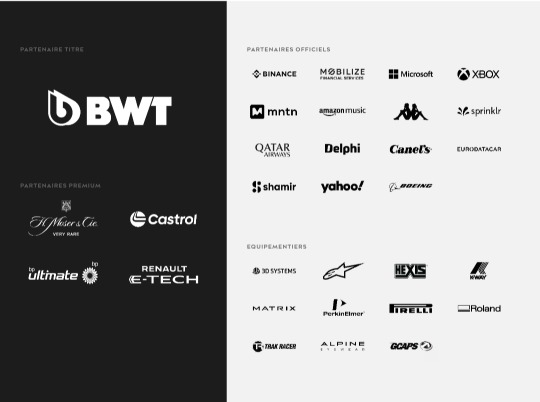
New sponsors: MNTN (American software company), H. Moser & Cie (Switzerland watch manufacturer), Amazon Music
Old sponsors that left: Bell & Ross (French watch company), Ecowatt (??? afaik French less-energy smthn smthn company), Elysium (French? American? Software company), KX (UK software company), Plug (American electrical equipment manufacturing company)
Visa CashApp RB F1 Team (prev. Scuderia Alpha Tauri):
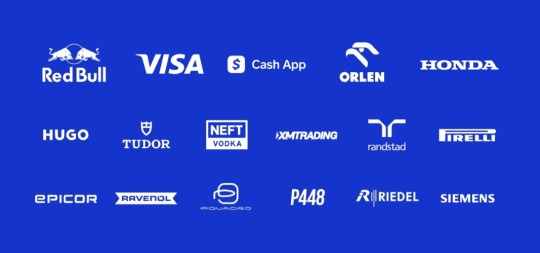
New Sponsors: Visa, CashApp, Hugo Boss, Tudor, Neft Vodka (Austrian alcoholic beverages company), Piquadro (Italian luxury bag manufacturer)
Old sponsors that left: Buzz (?), Carl Friedrik (UK travel goods manufacturer), Flex Box (Hongkong? shipping containers manufacturer), GMG (Emirati global wellbeing company), RapidAPI (American API company)
Haas F1 Team:

New sponsors: New Era (American cap manufacturer, joined later in 2023)
Old sponsors that left: Hantec Markets (Hongkong capital markets company), OpenSea (American NFT/Crypto company)
Williams Racing:


New sponsors: Komatsu, MyProtein (British bodybuilding supplement), Kraken (American crypto company, joined later in 2023), VAST Data (American tech company), Ingenuity Commerce (UK e-commerce platform), Puma (joined later in 2023)
Old sponsors that left: Acronis (Swiss software company), Bremont (British watch manufacturer), Dtex Systems (American? cybersecurity company), Financial Times (British business newspaper), Jumeirah Hotels & Resorts, KX (UK software company), OMP (Italian racing safety equipment manufacturer), PPG (American painting manufacturer), Umbro (English sports equipment manufacturer), Zeiss (German opticals/optometrics manufacturing company)
#mercedes amg petronas#red bull racing#scuderia ferrari#visa cash app rb#haas f1 team#mclaren f1#aston martin#alpine f1#williams racing#stake f1 team#f1#ari's rant#sponsor talks
42 notes
·
View notes
Text
Oracle Fusion Services in the UAE: Transforming Business Operations
The rapid advancement of technology is reshaping business operations across the globe, and the UAE is no exception. As one of the leading business hubs in the Middle East, the UAE has seen significant adoption of cutting-edge solutions to streamline business processes, enhance efficiency, and drive innovation. Among these solutions, Oracle Fusion Services have emerged as a critical enabler for digital transformation across various industries in the region.
What is Oracle Fusion?
Oracle Fusion is a suite of cloud applications designed to provide comprehensive, integrated solutions for enterprise resource planning (ERP), customer relationship management (CRM), human capital management (HCM), supply chain management (SCM), and more. Built on Oracle’s powerful cloud infrastructure, Fusion Applications offer scalable, flexible, and secure solutions that help organizations optimize their operations while adapting to rapidly changing market conditions.
The Growing Demand for Oracle Fusion in the UAE
In the Oracle Fusion service in UAE, businesses are increasingly recognizing the need for agile and future-proof solutions to maintain competitiveness. Oracle Fusion’s cloud-based architecture makes it an ideal choice for organizations looking to modernize their IT infrastructure without the burden of maintaining costly on-premise systems. By leveraging Oracle Fusion, companies can streamline their core business functions, reduce operational costs, and improve decision-making through real-time data analytics.
One of the major drivers for the adoption of Oracle Fusion in the UAE is the government’s focus on digital transformation, which is aligned with the UAE Vision 2030. This vision aims to diversify the economy, reduce reliance on oil, and create a knowledge-based economy. As part of this vision, businesses in the UAE are under pressure to adopt advanced technologies that enable them to operate more efficiently and sustainably.
Key Benefits of Oracle Fusion Services in the UAE
Scalability and Flexibility: Oracle Fusion allows businesses to scale their operations quickly and efficiently as they grow. Whether you are a small business or a large enterprise, the system can be tailored to meet your specific needs.
Enhanced Security: Data security is a top priority for businesses in the UAE, and Oracle Fusion offers advanced security features to protect sensitive information. With built-in compliance and encryption measures, businesses can rest assured that their data is safe.
Real-time Insights: One of the standout features of Oracle Fusion is its ability to provide real-time data insights. This helps businesses make informed decisions, forecast trends, and improve overall efficiency.
Improved Collaboration: Oracle Fusion’s unified platform fosters better collaboration among teams, departments, and even across different locations, which is essential for multinational companies operating in the UAE.
Conclusion
Oracle Fusion Services are playing a pivotal role in transforming the business landscape in the UAE. By offering a suite of flexible, secure, and scalable cloud applications, Oracle Fusion is helping organizations embrace digital transformation, streamline their operations, and stay competitive in a rapidly evolving market. As the UAE continues its journey toward becoming a global leader in innovation and technology, Oracle Fusion is well-positioned to support this vision.
2 notes
·
View notes
Text
Valkey 7.2 On Memorystore: Open-Source Key-Value Service
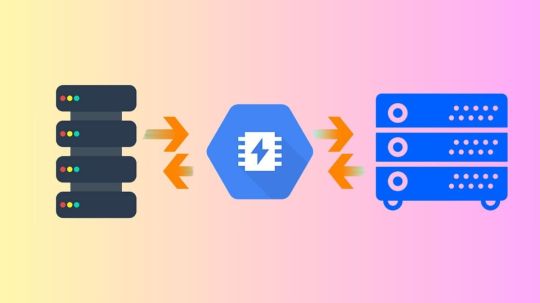
The 100% open-source key-value service Memorystore for Valkey is launched by Google Cloud.
In order to give users a high-performance, genuinely open-source key-value service, the Memorystore team is happy to announce the preview launch of Valkey 7.2 support for Memorystore.
Memorystore for Valkey
A completely managed Valkey Cluster service for Google Cloud is called Memorystore for Valkey. By utilizing the highly scalable, reliable, and secure Valkey service, Google Cloud applications may achieve exceptional performance without having to worry about handling intricate Valkey deployments.
In order to guarantee high availability, Memorystore for Valkey distributes (or “shards”) your data among the primary nodes and duplicates it among the optional replica nodes. Because Valkey performance is greater on many smaller nodes rather than fewer bigger nodes, the horizontally scalable architecture outperforms the vertically scalable architecture in terms of performance.
Memorystore for Valkey is a game-changer for enterprises looking for high-performance data management solutions reliant on 100% open source software. It was added to the Memorystore portfolio in response to customer demand, along with Memorystore for Redis Cluster and Memorystore for Redis. From the console or gcloud, users can now quickly and simply construct a fully-managed Valkey Cluster, which they can then scale up or down to suit the demands of their workloads.
Thanks to its outstanding performance, scalability, and flexibility, Valkey has quickly gained popularity as an open-source key-value datastore. Valkey 7.2 provides Google Cloud users with a genuinely open source solution via the Linux Foundation. It is fully compatible with Redis 7.2 and the most widely used Redis clients, including Jedis, redis-py, node-redis, and go-redis.
Valkey is already being used by customers to replace their key-value software, and it is being used for common use cases such as caching, session management, real-time analytics, and many more.
Customers may enjoy a nearly comparable (and code-compatible) Valkey Cluster experience with Memorystore for Valkey, which launches with all the GA capabilities of Memorystore for Redis Cluster. Similar to Memorystore for Redis Cluster, Memorystore for Valkey provides RDB and AOF persistence, zero-downtime scaling in and out, single- or multi-zone clusters, instantaneous integrations with Google Cloud, extremely low and dependable performance, and much more. Instances up to 14.5 TB are also available.
Memorystore for Valkey, Memorystore for Redis Cluster, and Memorystore for Redis have an exciting roadmap of features and capabilities.
The momentum of Valkey
Just days after Redis Inc. withdrew the Redis open-source license, the open-source community launched Valkey in collaboration with the Linux Foundation in March 2024 (1, 2, 3). Since then, they have had the pleasure of working with developers and businesses worldwide to propel Valkey into the forefront of key-value data stores and establish it as a premier open source software (OSS) project. Google Cloud is excited to participate in this community launch with partners and industry experts like Snap, Ericsson, AWS, Verizon, Alibaba Cloud, Aiven, Chainguard, Heroku, Huawei, Oracle, Percona, Ampere, AlmaLinux OS Foundation, DigitalOcean, Broadcom, Memurai, Instaclustr from NetApp, and numerous others. They fervently support open source software.
The Valkey community has grown into a thriving group committed to developing Valkey the greatest open source key-value service available thanks to the support of thousands of enthusiastic developers and the former core OSS Redis maintainers who were not hired by Redis Inc.
With more than 100 million unique active users each month, Mercado Libre is the biggest finance, logistics, and e-commerce company in Latin America. Diego Delgado discusses Valkey with Mercado Libre as a Software Senior Expert:
At Mercado Libre, Google Cloud need to handle billions of requests per minute with minimal latency, which makes caching solutions essential. Google Cloud especially thrilled about the cutting-edge possibilities that Valkey offers. They have excited to investigate its fresh features and add to this open-source endeavor.”
The finest is still to come
By releasing Memorystore for Valkey 7.2, Memorystore offers more than only Redis Cluster, Redis, and Memcached. And Google Cloud is even more eager about Valkey 8.0’s revolutionary features. Major improvements in five important areas performance, reliability, replication, observability, and efficiency were introduced by the community in the first release candidate of Valkey 8.0. With a single click or command, users will be able to accept Valkey 7.2 and later upgrade to Valkey 8.0. Additionally, Valkey 8.0 is compatible with Redis 7.2, exactly like Valkey 7.2 was, guaranteeing a seamless transition for users.
The performance improvements in Valkey 8.0 are possibly the most intriguing ones. Asynchronous I/O threading allows commands to be processed in parallel, which can lead to multi-core nodes working at a rate that is more than twice as fast as Redis 7.2. From a reliability perspective, a number of improvements provided by Google, such as replicating slot migration states, guaranteeing automatic failover for empty shards, and ensuring slot state recovery is handled, significantly increase the dependability of Cluster scaling operations. The anticipation for Valkey 8.0 is already fueling the demand for Valkey 7.2 on Memorystore, with a plethora of further advancements across several dimensions (release notes).
Similar to how Redis previously expanded capability through modules with restricted licensing, the community is also speeding up the development of Valkey’s capabilities through open-source additions that complement and extend Valkey’s functionality. The capabilities covered by recently published RFCs (“Request for Comments”) include vector search for extremely high performance vector similarly search, JSON for native JSON support, and BloomFilters for high performance and space-efficient probabilistic filters.
Former vice president of Gartner and principal analyst of SanjMo Sanjeev Mohan offers his viewpoint:
The advancement of community-led initiatives to offer feature-rich, open-source database substitutes depends on Valkey. Another illustration of Google’s commitment to offering really open and accessible solutions for customers is the introduction of Valkey support in Memorystore. In addition to helping developers looking for flexibility, their contributions to Valkey also support the larger open-source ecosystem.
It seems obvious that Valkey is going to be a game-changer in the high-performance data management area with all of the innovation in Valkey 8.0, as well as the open-source improvements like vector search and JSON, and for client libraries.
Valkey is the secret to an OSS future
Take a look at Memorystore for Valkey right now, and use the UI console or a straightforward gcloud command to establish your first cluster. Benefit from OSS Redis compatibility to simply port over your apps and scale in or out without any downtime.
Read more on govindhtech.com
#Valkey72#Memorystore#OpenSourceKey#stillcome#GoogleCloud#MemorystoreforRedisCluster#opensource#Valkey80#vectorsearch#OSSfuture#momentum#technology#technews#news#govindhtech
2 notes
·
View notes
Text
The Evolution and Impact of ERP Software in the UAE: A Comprehensive Analysis
ERP stands for Enterprise Resource Planning. It is a type of software system that integrates and manages core business processes and functions within an organization. ERP software typically provides a centralized database and a suite of applications that automate and streamline business activities across various departments such as finance, human resources, supply chain management, manufacturing, sales, and customer service.
In the fast-paced landscape of business operations, efficient management of resources and information is critical for success. Enterprises in the United Arab Emirates (UAE) have witnessed a remarkable transformation in their operational efficiency and competitiveness through the adoption of Enterprise Resource Planning (ERP) software. This article delves into the evolution, benefits, challenges, and future trends of ERP software within the UAE context.
In recent decades, Enterprise Resource Planning (ERP) software has played a transformative role in how businesses in the United Arab Emirates (UAE) operate and manage their resources. This article delves into the evolution, adoption, and impact of ERP systems within the UAE's business landscape. By exploring the unique challenges and opportunities presented by the UAE's dynamic economy, we can better understand how ERP software has become an indispensable tool for organizations seeking efficiency, integration, and scalability.
Evolution of ERP Software
The adoption of ERP software in the UAE mirrors global trends but is uniquely shaped by regional business requirements and technological advancements. In the early 2000s, ERP systems gained traction among larger corporations seeking to streamline their complex processes. Major multinational ERP providers like SAP, Oracle, and Microsoft Dynamics established a strong presence in the region, catering to diverse industry needs including finance, manufacturing, retail, and logistics.
A notable development in recent times is the movement towards cloud-centric ERP solutions.This transition offers scalability, flexibility, and cost-effectiveness, allowing businesses in the UAE to manage their operations more efficiently. Local ERP vendors have also emerged, offering tailored solutions that cater specifically to the nuances of the UAE market, such as compliance with local regulations and cultural practices.
Challenges and Obstacles
Despite the numerous benefits, ERP implementation in the UAE is not devoid of challenges. One prominent obstacle is the high initial investment required for ERP deployment, including software licensing, customization, and training costs. For smaller businesses, this financial commitment can be prohibitive, leading to slower adoption rates among SMEs.
Cultural factors and change management also pose challenges. Embracing new technology often requires a shift in organizational culture and employee mindsets. Resistance to change, coupled with the need for extensive training, can hinder the successful implementation of ERP systems in the UAE.
Furthermore, data security and privacy concerns are paramount, especially in light of stringent regulatory frameworks such as the UAE's Data Protection Law. Ensuring compliance with local data protection regulations adds complexity to ERP deployment, necessitating robust cybersecurity measures and data governance protocols.
The Business Landscape of the UAE
The UAE is renowned for its vibrant economy, diversified industries, and strategic geographical location. Over the years, the country has emerged as a global business hub attracting multinational corporations, SMEs, and startups alike. Key sectors such as finance, real estate, construction, logistics, tourism, and manufacturing contribute significantly to the nation's GDP. However, this diversification has also brought complexities in managing business operations efficiently.
The Emergence of ERP Solutions
As businesses in the UAE expanded and diversified, traditional methods of managing operations became inadequate. The need for integrated systems that could streamline processes across departments led to the rise of ERP solutions. Initially developed to manage manufacturing processes, ERP systems evolved to encompass finance, human resources, supply chain, customer relationship management, and more. This evolution mirrored the growth and diversification of UAE businesses.
Factors Driving ERP Adoption
Several factors have fueled the adoption of ERP software among businesses in the UAE:
Global Competition: The UAE's aspiration to compete on a global scale necessitated advanced operational efficiencies that ERP systems could deliver.
Regulatory Compliance: The UAE's regulatory environment, including VAT implementation, required robust financial and reporting capabilities that ERP systems could provide.
Scalability: With rapid economic growth, businesses needed scalable solutions to manage increasing complexities.
Integration Needs: As businesses diversified, the need for seamless integration across functions became crucial.
Challenges in ERP Implementation
While the benefits of ERP systems are substantial, implementing them poses challenges:
Cultural Factors: Embracing technological change and adopting new systems can face resistance due to cultural factors.
Resource Constraints: SMEs may struggle with the limited resources required for ERP implementation and customization.
Data Security and Privacy: The UAE's focus on data security and privacy necessitates robust ERP solutions compliant with local regulations.
Impact of ERP on UAE Businesses
The impact of ERP software on businesses in the UAE has been profound:
Improved Efficiency: Streamlined processes lead to increased productivity and reduced operational costs.
Enhanced Decision Making: Real-time data availability empowers businesses to make informed decisions.
Better Customer Experience: Integrated systems ensure seamless customer interactions and improved service delivery.
Regulatory Compliance: ERP systems aid in meeting regulatory requirements efficiently.
Key ERP Players in the UAE
Several global and regional ERP providers cater to the UAE market, offering tailored solutions to meet local business needs. Major players include SAP, Oracle, Microsoft Dynamics, Sage, and Epicor, among others.
Future Trends and Innovations
Looking ahead, several trends are poised to shape the future of ERP software in the UAE. Artificial Intelligence (AI) and Machine Learning (ML) are increasingly integrated into ERP systems, enabling predictive analytics and automation of routine tasks. This enhances decision-making capabilities and further optimizes business processes.
Mobile ERP applications are also gaining popularity, allowing stakeholders to access critical business data on the go. The rise of Industry 4.0 and the Internet of Things (IoT) is driving demand for ERP solutions that can seamlessly integrate with smart devices and sensors, enabling real-time monitoring and control of operations.
Moreover, the convergence of ERP with other technologies like blockchain promises enhanced transparency and security in supply chain management, crucial for industries like healthcare and finance.
Conclusion
In conclusion, ERP software has become an integral component of the UAE's business ecosystem, driving efficiency, integration, and growth across diverse sectors. While challenges exist, the transformative impact of ERP systems on businesses in the UAE underscores their importance in navigating complex operational landscapes. As technology continues to evolve, so too will the role of ERP in shaping the future of business in the UAE.ERP software has emerged as a transformative tool for businesses in the UAE, driving efficiency, innovation, and competitiveness across industries. Despite challenges such as high costs and cultural adaptation, the benefits of ERP implementation are substantial, ranging from streamlined operations to improved customer satisfaction. Looking ahead, the evolution of ERP software in the UAE is poised to align with global technological advancements, incorporating AI, IoT, and blockchain to unlock new possibilities for business growth and development. As enterprises continue to navigate the digital landscape, ERP remains a cornerstone of strategic management, enabling organizations to thrive in an increasingly complex and dynamic marketplace.
In summary, ERP software has been a game-changer for businesses in the UAE, enabling them to streamline operations, enhance decision-making, and adapt to a rapidly evolving marketplace. As the UAE continues to position itself as a global economic powerhouse, the role of ERP systems will remain pivotal in supporting the growth and sustainability of businesses across various sectors.
2 notes
·
View notes
Text
Exploring the Significance of ERP Software: How It Works, Why It's Vital for Companies, and the Benefits for Your Business
Enterprise Resource Planning (ERP) software stands as the backbone of modern businesses, planning a masterpiece of operations seamlessly. This comprehensive suite of integrated applications manages core business processes, including finance, HR, inventory, supply chain, and more. Its significance lies in its ability to streamline operations, enhance efficiency, and foster data-driven decision-making.
Cloud-based ERP solutions offer a versatile edge over traditional on-premises systems. They facilitate real-time data accessibility, scalability, and cost-effectiveness. Conversely, on-premises ERP software provides robust security and customization options, ideal for businesses with specific compliance needs or intricate operational structures.
Adopting the best ERP Software Consulting Solutions is a strategic move for companies, as it centralizes disparate processes into a unified platform, eradicates data silos, and enhances collaboration, thereby boosting productivity and offering a comprehensive view of the business for smarter, data-backed decisions."
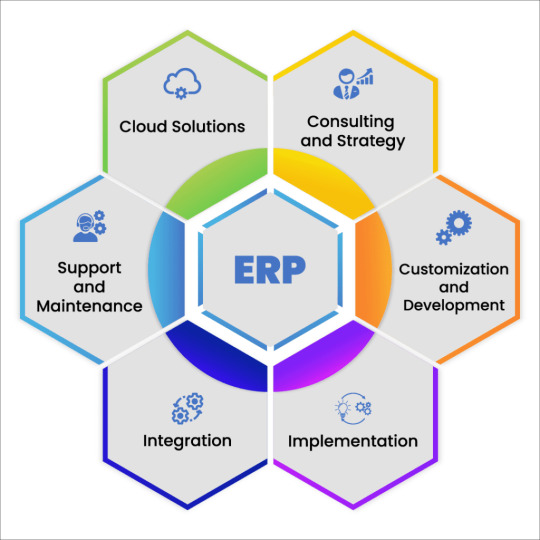
The benefits of ERP software for your business are multifaceted. It optimizes resource utilization, streamlines workflows, minimizes errors, and accelerates reporting cycles. This ultimately results in improved customer satisfaction, reduced operational costs, and better agility in responding to market changes.
When seeking the best ERP software development services, solutions, implementation, or consulting, businesses must prioritize expertise, reliability, and compatibility. The best ERP software development services and solutions cater to unique business needs, offering tailor-made solutions for seamless integration and functionality.
Choosing the best ERP software implementation services or solutions involves a thorough evaluation of the provider's track record, customer reviews, and adaptability to your company's requirements. Expert ERP software consulting services navigate businesses through the maze of choices, ensuring optimal software selection, implementation, and long-term success.
In conclusion, the strategic implementation of ERP software can revolutionize business operations, driving efficiency, innovation, and competitiveness. Selecting the best ERP software development, implementation, and consulting services is pivotal for maximizing the benefits and leveraging the full potential of this transformative technology.
ERP Offerings & Practice's
SAP/S4 HANA ERP Software Solutions
Ellucian Banner ERP Software Solutions
Peoplesoft ERP Software services
Oracle Cloud ERP Software services
UKG ERP Software services
Salesforce ERP Software services
3 notes
·
View notes
Text
What is the best IFRS software
Best International Financial Reporting Standards (IFRS) software because the choice of software depends on the specific needs and requirements of the organization. Different companies may have distinct preferences based on factors such as size, industry, complexity of financial reporting, and integration capabilities with existing systems.
However, there are several reputable software solutions that are commonly used for IFRS reporting and compliance. Keep in mind that the landscape might have changed, and new solutions may have emerged since my last update.
Workiva:
Workiva offers cloud-based solutions for finance, compliance, and data management. It is known for its collaborative and workflow management features.
Tagetik (owned by Wolters Kluwer):
Tagetik provides a unified platform for financial performance management, including IFRS reporting. It is designed to streamline funds processes and improve compliance.
Oracle Financial Services Analytical Applications (OFSAA):
Oracle's OFSAA suite includes modules for various budgetary functions, including regulatory info. It is designed to help wealthy institutions comply with IFRS and other reporting standards.
SAP S/4HANA:
SAP's ERP solution, S/4HANA, includes financial modules that can support IFRS. SAP is widely used in large enterprises across various industries.
Datar ails:
Data Rails offers a platform that automates funds reporting, budgeting, and forecasting. It is designed to improve the accuracy and efficiency of income processes.
Hubble (by insight software):
Hubble is an integrated suite of performance management apps. It provides solutions for financial reporting, analytics, and planning.
OneStream Software:
OneStream offers a unified CPM (Corporate Performance Management) platform that includes solutions for financial consolidation and planning, supporting IFRS compliance.
When choosing an IFRS software solution, it's essential to consider factors such as the organization's specific information needs, budget, scalability, ease of use, and integration capabilities with existing systems. Additionally, staying informed about updates and reviews in the financial software market is crucial to ensuring that the chosen solution meets the latest standards and regulations.
2 notes
·
View notes
Text
The Crucial ERP System Examples: Transforming Business Operations

In today’s fiercely competitive business realm, the quest for operational efficiency and streamlined management is paramount. Enterprise Resource Planning (ERP) systems stand tall as technological marvels, revolutionizing the way businesses operate. These robust software solutions amalgamate various functions within a unified framework, enabling seamless coordination across departments and facilitating data-driven decision-making.
This exploration ventures into the realm of ERP systems, shedding light on a spectrum of exemplary solutions that have reshaped modern business operations. From stalwarts like SAP ERP and Oracle ERP Cloud to innovative players like Microsoft Dynamics 365 and Odoo, each system represents a unique amalgamation of features, functionalities, and industry applications.
This comprehensive journey traverses the functionalities, industry adaptability, and transformative potentials of these ERP systems. Understanding their intricacies is pivotal for businesses seeking to optimize processes, unlock efficiencies, and navigate the complexities of today’s business landscape. Join this insightful exploration to unravel the significance and impact of these ERP system examples in shaping the future of business operations.
ERP System Examples
1. SAP ERP: Revolutionizing Business Management
SAP ERP has solidified its position as a leader by providing an all-encompassing suite covering critical business functions. Beyond its core modules in finance, HR, and supply chain, SAP offers specialized applications for industry-specific needs. For instance, SAP S/4HANA, an intelligent ERP, integrates AI and analytics for real-time insights, empowering businesses to adapt swiftly to market changes.
The scalability of SAP ERP is noteworthy, catering to startups aiming for growth and global corporations managing complex operations. It provides modular solutions, enabling businesses to adopt specific functionalities based on their immediate needs.
2. Oracle ERP Cloud: Innovating Operations in the Cloud
Oracle ERP Cloud’s robust suite extends far beyond traditional ERP capabilities. It embraces emerging technologies like AI, machine learning, and blockchain to drive innovation. Its predictive analytics empower businesses to anticipate market trends, optimize supply chains, and mitigate risks effectively.
The cloud-based structure of Oracle ERP Cloud ensures not just accessibility but also scalability without compromising security. It enables seamless integration with other Oracle Cloud applications, fostering a unified ecosystem for comprehensive business management.
3. Microsoft Dynamics 365: Integrating CRM and ERP Capabilities
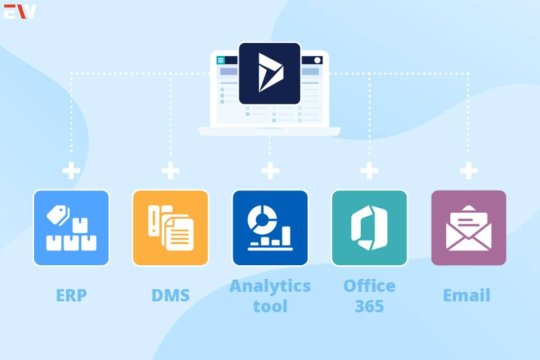
Microsoft Dynamics 365 is a fusion of CRM and ERP functionalities, providing a holistic platform for businesses. Unlike its core ERP modules, Dynamics 365 offers advanced tools for customer engagement, field service, and marketing automation. Its flexibility lies in its modularity, allowing businesses to tailor their systems by choosing specific applications that align with their objectives.
Moreover, its integration with Microsoft Office 365 and Power Platform strengthens collaboration and data analysis, facilitating informed decision-making across departments.
4. NetSuite: Empowering Diverse Industries
NetSuite’s cloud-based ERP system addresses the complex needs of various industries. Its suite encompasses solutions for financial management, e-commerce, and inventory control. Beyond the core ERP functionalities, NetSuite offers industry-specific modules, such as SuiteCommerce for retail businesses and SuiteSuccess for services, enhancing its appeal across diverse sectors.
The scalability and adaptability of NetSuite make it a preferred choice for businesses experiencing rapid growth or seeking to expand into new markets.
5. Infor ERP: Tailored Solutions for Specific Sectors
Infor’s industry-specific ERP solutions cater to the nuanced requirements of sectors like healthcare, manufacturing, and distribution. In addition to its standard ERP functionalities, Infor focuses on specialized applications such as Infor CloudSuite Healthcare for healthcare organizations and Infor LN for manufacturing, ensuring tailored solutions for sector-specific challenges.
Infor’s commitment to innovation and addressing sector-specific complexities underscores its relevance in the ERP landscape.
6. Epicor ERP: Amplifying Industry Operations
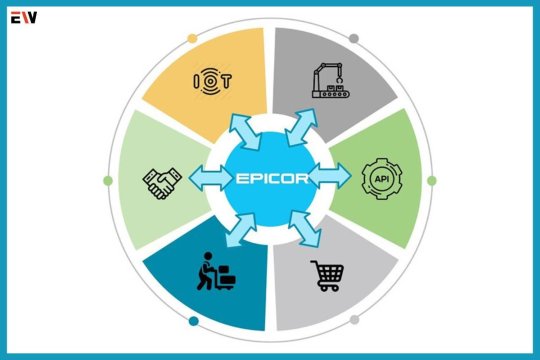
Epicor ERP excels in catering to industries such as manufacturing, distribution, retail, and services. Its core ERP functionalities are complemented by advanced analytics and business intelligence tools. Epicor’s Smart Inventory Planning and Optimization (IPO) tool, for instance, utilizes AI to enhance inventory management, improving efficiency and reducing costs.
Moreover, its agile architecture enables easy customization and integration with third-party applications, providing businesses with a highly adaptable solution.
7. Odoo: Flexibility and Customization
Odoo’s open-source ERP system offers an extensive suite of applications covering CRM, inventory management, project management, and more. What sets Odoo apart is its modular nature, allowing businesses to select and integrate specific applications as per their requirements. Odoo’s flexibility and affordability are especially beneficial for small to medium-sized enterprises seeking customizable solutions without exorbitant costs.
The Value of ERP Systems in Modern Business
ERP systems serve as catalysts for efficiency, productivity, and growth:
Streamlined Operations: Automating tasks streamlines processes, reducing manual errors and optimizing resource allocation.
Enhanced Data Management: Centralized databases ensure data consistency and accuracy, fostering informed decision-making.
Agile Decision-Making: Real-time data access empowers businesses to make agile decisions, staying ahead in dynamic markets.
Customer-Centric Approach: Integrated CRM functionalities enable businesses to deliver personalized services, boosting customer satisfaction and loyalty.
Making Informed Choices: Selecting the Right ERP System

The process of choosing an ERP system involves careful evaluation and alignment with a business’s unique needs. Understanding the scalability, integration capabilities, and industry-specific functionalities of each system is crucial for successful adoption.
Conclusion: Embracing ERP Systems for Sustainable Growth
The landscape of ERP systems continues to evolve, offering businesses versatile solutions to streamline operations, enhance efficiency, and foster sustainable growth. From SAP’s scalability to Oracle’s cloud-driven innovation and Odoo’s customization prowess, each system exemplifies the diverse capabilities shaping modern business management.
Selecting the right ERP system aligned with specific needs remains pivotal for organizations seeking resilience and competitiveness. As businesses strive for optimization and adaptability, embracing these transformative technologies ensures a strategic advantage in an ever-evolving market. It stands as a pillar of efficiency, empowering businesses to navigate complexities and drive success through informed decisions and streamlined operations.
Also Read: A Deep Dive into Corporate Wellness Programs for a Healthier, Happier Workplace
#ERPRevolution#BusinessTransformation#TechInnovation#DigitalTransformation#EnterpriseSolutions#InnovationInBusiness#TechLeadership
2 notes
·
View notes
Text
The Top Choice: Oracle Enterprise Resource Planning Cloud Service for Your Business Success
Are you searching for the best solution to streamline your business operations? Look no further than the Top Choice: Oracle Enterprise Resource Planning (ERP) Cloud Service. In today's fast-paced business world, organizations need a robust ERP solution to optimize their processes, enhance productivity, and drive growth. Oracle ERP Cloud Service, crowned as the best in the industry, offers a comprehensive suite of tools designed to meet the demands of modern businesses.
Why Choose the Best: Oracle Enterprise Resource Planning Cloud Service?
Oracle ERP Cloud Service stands out as the Best Option for businesses across various industries. Here's why:
Scalability: Easily scale your ERP system as your business grows, always ensuring seamless operations.
Integration: Integrate ERP with other Oracle Cloud services for a unified business platform.
Real-time Insights: Gain valuable insights into your business with real-time analytics, enabling data-driven decision-making.
Security: Rest easy knowing your data is secure with Oracle's advanced security features.
Frequently Asked Questions about the Best Choice: Oracle ERP Cloud Service
Q1: What modules are included in Oracle ERP Cloud Service?
A1: Oracle ERP Cloud Service includes modules for financial management, procurement, project management, supply chain management, and more. Each module is designed to optimize specific aspects of your business.
Q2: Is Oracle ERP Cloud Service suitable for small businesses?
A2: Yes, Oracle ERP Cloud Service is scalable and can be tailored to meet the needs of small, medium, and large businesses. It offers flexible solutions suitable for businesses of all sizes.
Q3: How does Oracle ERP Cloud Service enhance collaboration among teams?
A3: Oracle ERP Cloud Service provides collaborative tools that enable teams to work together seamlessly. Features like shared calendars, document management, and task tracking enhance communication and collaboration.
Conclusion: Empower Your Business with the Best ERP Solution
Oracle Enterprise Resource Planning Cloud Service is not just a choice; it's the Ultimate Solution for businesses seeking to optimize their operations. By harnessing the power of Oracle ERP, you can streamline processes, improve efficiency, and drive innovation. Don't let outdated systems hold your business back. Embrace the future with Oracle ERP Cloud Service and propel your business to new heights.
Ready to transform your business? Contact us today to explore the endless possibilities with the best ERP solution on the market.
#oracle#oracle erp#rapidflow#oracle erp cloud service#best erp solution#oracle erp service providers#business#business automation#oracle services#enterprise software#scalability#integration#rpa#market#erp
3 notes
·
View notes
Text
ERP Solutions in Dubai: Empowering Businesses with Smart Digital Transformation
In the heart of the Middle East’s business capital, ERP solutions in Dubai are revolutionizing the way organizations operate. From startups to large enterprises, companies across industries are leveraging ERP systems to simplify processes, enhance productivity, and drive smarter decision-making.
Dubai’s progressive economy and its vision for digital excellence have made it a fertile ground for adopting advanced ERP software. Whether you're a manufacturer, retailer, or part of the service sector, ERP helps unify all core functions into one intelligent system—finance, inventory, HR, sales, and customer service.
Why Businesses in Dubai Need ERP Solutions
Dubai is a hub for global trade, logistics, real estate, and finance. To remain competitive, businesses must be agile and data-driven. This is where ERP solutions in UAE deliver value. Key benefits include:
Centralized data access across departments
Real-time reporting and analytics
Compliance with UAE VAT and financial regulations
Cost optimization through automation
Scalability to match business growth
Top Features of Modern ERP Systems
The best ERP software in Dubai offers:
✅ Cloud-based ERP architecture for remote accessibility ✅ Integration with CRM and HRMS modules ✅ Custom workflows for specific industry needs ✅ Mobile-friendly dashboards ✅ Automated inventory and supply chain tracking
Industries Benefiting from ERP in Dubai
ERP solutions are versatile and support diverse sectors such as:
Logistics and Supply Chain – With powerful logistics ERP software
Retail & E-commerce – Inventory, billing, and customer data in one place
Manufacturing – Optimize production, quality control, and resource planning
Construction & Real Estate – Project tracking, budgeting, and client management
Finance & Accounting – Integrated ERP accounting software for accurate reporting
Popular ERP Platforms in Dubai
Companies in Dubai often choose:
Odoo ERP – Flexible, open-source erp, and widely adopted
SAP Business One – Scalable ERP for growing businesses
Oracle NetSuite – Cloud ERP for financial management
Microsoft Dynamics 365 – Integrated solution for enterprise-level control
Final Thoughts
As Dubai continues its digital journey, ERP solutions are no longer a luxury—but a necessity. Choosing the right ERP provider can streamline your operations, reduce overhead, and set your business up for sustainable growth.
🚀 Ready to Upgrade Your Business with ERP?
At Banibro IT Solution, we deliver custom ERP solutions in Dubai tailored to your unique business needs—whether you’re in manufacturing, retail, logistics, or finance.✅ Get a Free Odoo Demo 📞 Call Us Today
0 notes
Link
SpiritSofts, a leading training institute, offers the Best Oracle EDMCS Online Training. Our comprehensive program covers all aspects of Oracle EDMCS, led by industry experts. Gain hands-on experience in data modeling, metadata management, and data integration. Learn effective change management and collaboration techniques. Elevate your data management skills with SpiritSofts' top-notch training. Enroll now to excel in Oracle EDMCS and unlock new career opportunities.
#https://www.spiritsofts.com/oracle-edmcs-online-training/#Master Oracle EDMCS: Best Online Training for Enterprise Data Management#🚀 Unlock the full potential of Oracle Enterprise Data Management Cloud Service (EDMCS) with our comprehensive online training! 🎓 Learn how#OracleEDMCS EnterpriseDataManagement EDMCSTraining DataGovernance DataModeling DataHierarchies DataManagement CloudService OracleTraining Da
0 notes
Text
In-Memory Computing Market Size, Share, Trends, Growth Opportunities and Competitive Outlook
Executive Summary In-Memory Computing Market :
Global in-memory computing market size was valued at USD 30.43 billion in 2023 and is projected to reach USD 170.09 billion by 2031, with a CAGR of 24.00% during the forecast period of 2024 to 2031.
The key factors discussed in the report will surely aid the buyer in studying the In-Memory Computing Market on competitive landscape analysis of prime manufacturers, trends, opportunities, marketing strategies analysis, market effect factor analysis and consumer needs by major regions, types, applications in Global In-Memory Computing Market considering the past, present and future state of the industry. Competitive analysis conducted in this report makes you aware about the moves of the key players in the market such as new product launches, expansions, agreements, joint ventures, partnerships, and acquisitions. The report also includes the detailed profiles for the In-Memory Computing Market’s major manufacturers and importers who are influencing the market.
In-Memory Computing Market report not only provides knowledge and information about all the recent developments, product launches, joint ventures, mergers and acquisitions by the several key players and brands but also acts as a synopsis of market definition, classifications, and market trends. Estimations about the rise or fall of the CAGR value for specific forecast period, market drivers, market restraints, and competitive strategies are evaluated in the report. The In-Memory Computing Market report gives details about market trends, future prospects, market restraints, leading market drivers, several market segments, key developments, key players in the market, and competitor strategies.
Discover the latest trends, growth opportunities, and strategic insights in our comprehensive In-Memory Computing Market report. Download Full Report: https://www.databridgemarketresearch.com/reports/global-in-memory-computing-market
In-Memory Computing Market Overview
**Segments**
- Based on component, the Global In-Memory Computing Market can be segmented into solutions and services. The solutions segment can further be categorized into in-memory data management and in-memory application platforms. The services segment includes consulting, implementation, and support and maintenance services. - On the basis of organization size, the market is divided into small and medium-sized enterprises (SMEs) and large enterprises. In-memory computing solutions are implemented by both SMEs and large enterprises to boost their operational efficiency and achieve real-time data processing. - In terms of deployment mode, the market can be segmented into on-premises and cloud-based deployment. The cloud-based deployment model is gaining popularity due to its flexibility, scalability, and cost-effectiveness. - By vertical, the in-memory computing market is segmented into BFSI, healthcare, retail, manufacturing, IT and telecom, government, and others. The BFSI sector is a major contributor to the market growth as in-memory computing helps financial institutions in real-time risk management and fraud detection.
**Market Players**
- Some of the key market players in the Global In-Memory Computing Market include SAP SE, Oracle, IBM, GigaSpaces, Hazelcast, GridGain Systems, TIBCO Software, Software AG, and Microsoft Corporation. These companies are focusing on product innovations, strategic partnerships, and acquisitions to enhance their market presence and expand their customer base. - Other notable players in the market are Intel Corporation, VMware, Altibase Corporation, MemVerge, Exasol, and ScaleOut Software. These players are actively investing in research and development activities to introduce advanced in-memory computing solutions that cater to the evolving needs of organizations across different industry verticals.
In the Global In-Memory Computing Market, one emerging trend is the growing adoption of in-memory computing solutions for data analytics and business intelligence. Organizations across various sectors are leveraging in-memory computing technology to gain real-time insights from their data, enabling them to make informed decisions quickly and stay ahead in today's competitive landscape. This trend is driven by the increasing need for faster processing speeds and improved performance in handling large volumes of data. By utilizing in-memory computing solutions, businesses can eliminate data latency issues and enhance their overall operational efficiency.
Another key development in the market is the rising demand for in-memory computing in the healthcare sector. With the healthcare industry generating massive amounts of data from electronic health records, medical imaging, and patient monitoring systems, there is a growing need for real-time data processing and analysis to improve patient care and support clinical decision-making. In-memory computing solutions enable healthcare providers to access and analyze critical information instantaneously, leading to better patient outcomes, reduced costs, and increased operational efficiency within healthcare facilities.
Furthermore, the integration of in-memory computing technology with artificial intelligence (AI) and machine learning (ML) capabilities is set to drive significant advancements in the market. By combining in-memory computing with AI and ML algorithms, organizations can enhance their data processing capabilities, automate decision-making processes, and unlock valuable insights from complex datasets. This convergence of technologies opens up new opportunities for businesses to extract actionable intelligence from their data, optimize operations, and drive innovation across various industry verticals.
Additionally, the market is witnessing a surge in strategic collaborations and partnerships among key players to accelerate product development and expand their global footprint. Companies are joining forces to integrate complementary technologies, enhance interoperability, and deliver comprehensive in-memory computing solutions that address the diverse needs of customers. These partnerships enable market players to leverage each other's strengths, access new markets, and create synergies that drive innovation and drive market growth.
Overall, the Global In-Memory Computing Market is poised for substantial growth driven by the increasing demand for real-time data processing, the rising adoption of in-memory computing across diverse industry verticals, and the convergence of technologies like AI and ML. As organizations continue to prioritize data-driven decision-making and digital transformation initiatives, in-memory computing solutions will play a pivotal role in enabling enterprises to unlock the full potential of their data assets, drive business agility, and stay competitive in today's fast-paced digital economy.One significant aspect impacting the Global In-Memory Computing Market is the increasing focus on real-time data processing capabilities across various industry verticals. Organizations are recognizing the need to harness the power of in-memory computing solutions to analyze data instantaneously, enabling them to make timely and informed decisions that can drive operational efficiency and competitive advantage. The ability to access and process large volumes of data in real-time is becoming a crucial differentiator for businesses looking to stay ahead in the rapidly evolving digital landscape. As a result, the demand for in-memory computing technologies is expected to witness steady growth as more companies seek to leverage these solutions for enhanced data analytics and business intelligence applications.
Moreover, the integration of in-memory computing with advanced technologies such as artificial intelligence (AI) and machine learning (ML) is poised to revolutionize the market further. By combining in-memory computing capabilities with AI and ML algorithms, organizations can unlock deeper insights from their data, automate decision-making processes, and drive innovative solutions across various sectors. The synergy created by merging these technologies offers businesses a competitive edge by enabling them to extract actionable intelligence, optimize operations, and drive transformative changes in how data is processed and utilized. This convergence presents a wealth of opportunities for market players to develop innovative solutions that cater to the evolving needs of businesses across different industries, fueling further growth and advancement in the in-memory computing market.
Additionally, the healthcare sector's increasing adoption of in-memory computing solutions for real-time data processing and analysis represents a significant growth opportunity in the market. With the healthcare industry generating vast amounts of data from various sources, the ability to access and analyze this information instantly can vastly improve patient care, enhance clinical decision-making, and drive operational efficiencies within healthcare organizations. In-memory computing technologies offer healthcare providers the capability to extract critical insights from complex datasets rapidly, leading to better patient outcomes, cost savings, and overall improvements in the quality of care delivered. This trend is expected to drive substantial growth in the adoption of in-memory computing solutions within the healthcare sector, creating new avenues for market players to innovate and expand their presence in this burgeoning market segment.
In conclusion, the Global In-Memory Computing Market is undergoing significant transformations driven by the increasing demand for real-time data processing, the integration of advanced technologies like AI and ML, and the expanding adoption of in-memory computing solutions across diverse industry verticals. Organizations are embracing these technologies to unlock the full potential of their data assets, gain competitive advantages, and drive business growth in a data-driven digital economy. As the market continues to evolve, market players have the opportunity to capitalize on these trends, innovate new solutions, and establish strong footholds in the rapidly expanding in-memory computing landscape.
The In-Memory Computing Market is highly fragmented, featuring intense competition among both global and regional players striving for market share. To explore how global trends are shaping the future of the top 10 companies in the keyword market.
Learn More Now: https://www.databridgemarketresearch.com/reports/global-in-memory-computing-market/companies
DBMR Nucleus: Powering Insights, Strategy & Growth
DBMR Nucleus is a dynamic, AI-powered business intelligence platform designed to revolutionize the way organizations access and interpret market data. Developed by Data Bridge Market Research, Nucleus integrates cutting-edge analytics with intuitive dashboards to deliver real-time insights across industries. From tracking market trends and competitive landscapes to uncovering growth opportunities, the platform enables strategic decision-making backed by data-driven evidence. Whether you're a startup or an enterprise, DBMR Nucleus equips you with the tools to stay ahead of the curve and fuel long-term success.
Influence of the In-Memory Computing Market Report:
Comprehensive assessment of all opportunities and risk in the In-Memory Computing Market
Lead In-Memory Computing Market recent innovations and major events
Detailed study of business strategies for growth of the In-Memory Computing Market market-leading players
Conclusive study about the growth plot of In-Memory Computing Market for forthcoming years
In-depth understanding of In-Memory Computing Market -particular drivers, constraints and major micro markets
Favourable impression inside vital technological and In-Memory Computing Marketlatest trends striking the Cannabis Seeds Market
Browse More Reports:
Global Non-Anti Coagulant Rodenticides Market Global Clinical Trial Supplies Market Global Food Grade Maltodextrin Market Global Freight Transportation Management Market Asia-Pacific Stand-Up Paddleboard Market North America Fiber Optic Connector in Telecom Market Global Tattoo Removal Devices Market Global Hair Dryer Market Global Food Dispenser Market U.S. Cerebral Palsy Market Global Surgical Case Carts Market Global Tetanus Market Global Fiber Optic Connector in Telecom Market Europe API Intermediates Market Global Ophthalmology Drugs and Devices Market Middle East and Africa System Integrator Market for Retail and Consumer Goods – Industry Trends and Forecast to 2029 Global Gastroesophageal Reflux Disease Market Global Grocery Market Global Chinese Hamster Ovary (CHO) Cells Market Global Egg Protein Market North America Anti-Acne Cosmetics Market North America Soy Protein Concentrate Market Global Glazing Gel Market Global Single Photon Emission Computerized Tomography (SPECT) Probes Market Global Bipolar Discrete Semiconductor Market Global Digital Television (TV) Market Europe Biostimulants Market Global Non-Toluene Ink for Flexible Packaging Market Middle East and Africa Reverse Logistics Market Global Pharmaceutical Pellets Market North America Printing Inks/Packaging Inks Market Middle East and Africa Clinical Trial Supplies Market Global Lactase Enzyme Market Asia-Pacific 3D Display Market
About Data Bridge Market Research:
An absolute way to forecast what the future holds is to comprehend the trend today!
Data Bridge Market Research set forth itself as an unconventional and neoteric market research and consulting firm with an unparalleled level of resilience and integrated approaches. We are determined to unearth the best market opportunities and foster efficient information for your business to thrive in the market. Data Bridge endeavors to provide appropriate solutions to the complex business challenges and initiates an effortless decision-making process. Data Bridge is an aftermath of sheer wisdom and experience which was formulated and framed in the year 2015 in Pune.
Contact Us: Data Bridge Market Research US: +1 614 591 3140 UK: +44 845 154 9652 APAC : +653 1251 975 Email:- [email protected]
Tag: In-Memory Computing, In-Memory Computing Size, In-Memory Computing Share, In-Memory Computing Growth
0 notes
Text
From Chaos to Clarity: A Step-by-Step Guide to Migrating Legacy Systems to Cloud CRMs

Migrating from a legacy system to a cloud-based Customer Relationship Management (CRM) platform is one of the most impactful moves a small business can make. With growing demands for speed, accuracy, and customer personalization, traditional on-premise solutions simply can’t keep up. Fortunately, Cloud CRM Solutions offer a smarter, more agile way to manage customer data and business processes. In this guide, we’ll walk you through how to make that transition efficiently and effectively.
Learn more about CRM transformation at AeyeCRM.
Why Move to a Cloud CRM?
The Limits of Legacy Systems
Legacy systems, though once cutting-edge, now present significant operational challenges:
Inflexibility: Hard to update and incompatible with modern apps
High Maintenance Costs: Expensive hardware and dedicated IT staff
Limited Accessibility: Cannot be accessed remotely or on mobile
Poor Data Visibility: Disconnected data silos across departments
By contrast, Cloud CRM Solutions provide scalable, cost-effective access to real-time customer data, integrate smoothly with other platforms, and improve team collaboration.
Market Trends and Insights
According to Gartner, by 2027, over 80% of CRM deployments will be cloud-based.
SMBs adopting cloud CRMs report a 35% boost in customer satisfaction and 25% faster sales cycle closure.
Step-by-Step: Migrating Legacy Systems to a Cloud CRM
Step 1: Assess Your Current System
Before making the switch, evaluate what your legacy system is currently handling:
Which processes are outdated or inefficient?
What data is critical to retain?
Are there integration needs with ERP or marketing platforms?
This analysis helps create a roadmap for your CRM implementation for SMBs that minimizes disruption.
Step 2: Select the Right Cloud CRM
Small businesses often choose platforms like Salesforce, Zoho, or HubSpot for their user-friendly interfaces and scalability. Working with Salesforce consulting partners such as AeyeCRM ensures the platform fits your exact business model and industry.
Step 3: Cleanse and Prepare Your Data
Legacy systems are notorious for messy, duplicated, or incomplete data. Before migration:
Eliminate outdated or duplicate records
Standardize formats (e.g., phone numbers, addresses)
Tag or classify key accounts for segmentation
Step 4: Migrate in Phases
Instead of switching everything at once, migrate in stages:
Start with one team (e.g., Sales or Customer Service)
Test and adjust workflows
Use feedback to refine other departments' rollouts
Step 5: Integrate with Cloud ERP (Optional)
For maximum operational efficiency, consider Cloud ERP integration. Syncing your CRM with platforms like Oracle NetSuite or Microsoft Dynamics can automate back-end processes such as invoicing, inventory updates, and procurement.
Step 6: Train and Support Your Team
Your CRM is only as good as your team’s ability to use it. Provide:
Role-specific training sessions
Quick-reference guides
Ongoing support from implementation partners like AeyeCRM
Step 7: Monitor Performance and Optimize
Once live, track KPIs such as:
Lead conversion rates
Sales cycle length
Customer satisfaction (CSAT scores)
Use built-in reporting tools to continuously optimize processes.
Case Study: How a Startup Made the Leap
A healthcare startup in New York transitioned from a paper-based legacy CRM to Salesforce with the help of AeyeCRM. The migration was completed in six weeks. Results included:
50% faster lead-to-sale conversion
40% improvement in customer response time
Integration with their ERP system for real-time billing updates
Key Benefits of Migrating to Cloud CRM
Cost Savings: Eliminate hardware costs and reduce IT overhead
Scalability: Easily add users and features as your business grows
Mobility: Access customer data from anywhere
Automation: Trigger follow-ups, reminders, and tasks automatically
Security: Benefit from enterprise-grade security and compliance
Common Migration Challenges (and How to Avoid Them)
Underestimating data complexity: Do a full audit before moving anything
Insufficient team buy-in: Communicate benefits clearly and involve stakeholders early
Skipping testing: Pilot the system with a small group before full deployment
Frequently Asked Questions (FAQs)
What is a legacy CRM system?
A legacy CRM system is an older platform, often hosted on-premise, that lacks modern features like mobile access, cloud integration, and automation.
How long does migration usually take?
Depending on your data volume and business complexity, migration can take 4 to 12 weeks.
Is cloud CRM secure?
Yes. Reputable platforms like Salesforce and Zoho provide enterprise-grade security features, including encryption and access controls.
What are the costs involved?
Costs vary based on licensing, customization, and consulting. However, most businesses recover their investment within 6 to 12 months.
Does AeyeCRM help with both CRM and ERP integration?
Yes. AeyeCRM specializes in CRM implementation for SMBs and also provides expert support for Cloud ERP integration to ensure end-to-end system efficiency.
Conclusion
Migrating to a cloud-based CRM doesn’t have to be overwhelming. With careful planning, the right tools, and expert guidance, you can turn disorganized legacy systems into streamlined customer-focused engines.
Contact us today to explore tailored CRM and cloud integration solutions.
0 notes
Text
What Are the Key Roles in IT Infrastructure Management?
In the modern business age of the digital world, IT Infrastructure Management is what keeps businesses running well. The task of IT infrastructure management entails efforts made in diverse areas, including the maintenance of network performance and protection of the data security. But what are exactly the major roles that make this ecosystem to be efficient?
What are the most central positions and responsibilities that propel up a reliable, safe and scalable IT infrastructure? Let us go over them at a time.

1. IT Infrastructure Manager
The head of the ladder is IT Infrastructure Manager. Such an individual is involved in planning, designing and executing the whole IT infrastructure of an organization. They make sure that every hardware, software, network as well as cloud-based service are in line with business objectives.
They have day to day tasks of budgeting IT resources, vendor selection, team management, decisions on upgrade or change of systems among others. They also liaise with the top level management to ensure that the roadmap of the infrastructure matches the growth strategies of the business.
2. Network Administrator
The Network Administrator has the duty to maintain the network systems in the company. These are local area networks (LAN), wide area networks (WAN), firewalls, routers and switches. It is their task to maintain continuous connectivity and solve any problems connected with network performance.
They can be found in the background, doing software update and vulnerability patching and management, and uptime. Businesses would be experiencing constant blackouts and jeopardized security without network administrators.
3. System Administrator
System Administrators are often mixed up with the network administrators, but they take more attention to the machines, operating systems and servers. They administer, modify, and guarantee stable performance of the computer systems particularly the multi-user computers such as servers.
General system admins are involved in a user setup, maintenance of accesses, backup, and system status. They also do software upgrades and repair hardware.
4. Database Administrator (DBA)
Most businesses rely on data in the world today. Database Administrator makes sure that vital information is stored, retrieved, and secured in a streamlined way. They keep up database platforms such as Oracle, SQL Server or MySQL, according to the requirements of the organization.
They clean up performances, configure backup and recovery procedures, apply data access control, and observe storage. They also collaborate with security departments in ensuring they guard information that may be accessed or lost without authorization.
5. Cloud Infrastructure Engineer
As other enterprises increasingly migrate to the cloud, the importance of a Cloud Infrastructure Engineer has gotten significant adoption. Such experts control systems operating in the cloud: AWS, Azure or Google Cloud.
They are to implement virtual servers, allow cloud security, cloud cost optimization, and deployment automation. They make sure that the organization takes advantage of the use of cloud technology in an effective way that neither performance nor security is affected.
6. IT Security Specialist
Cybersecurity is not an option anymore. IT Security Specialist is specialized in ensuring the safety of the infrastructure against threats, breach and vulnerability. They would watch networks and look at certain abnormal activities, use firewalls, and encrypt data, and they would make security audits frequently.
They also teach the other members of the team about good practices and adherence to regulations such as GDPR, HIPAA, etc.
7. Help Desk and Support Teams
The IT Support and Help Desk Teams are the ones who are frequently ignored, but at the same time, his workforce has to be part of the management of an infrastructure. The employees contact them when there are technical problems.
Such specialists are involved in password recovery, installation of software, and assistance. Proper support team eases productivity as issues are solved within the shortest time possible.
Conclusion
IT Infrastructure Management relies on all the diverse jobs dedicated to keep the system stable, performing well, and secure. All the job titles, be they network administrator, system admin, or cloud engineer are essential to guarantee a well-functioning technology foundation of an enterprise. The right team in the right place is not only important, but also necessary as the organizations keep on expanding and changing. Knowledge of these top functions will help businesses to organize their IT departments, prevent their outages, as well as being ready to meet any technological needs in future.
1 note
·
View note
Text
HPE Servers' Performance in Data Centers
HPE servers are widely regarded as high-performing, reliable, and well-suited for enterprise data center environments, consistently ranking among the top vendors globally. Here’s a breakdown of their performance across key dimensions:
1. Reliability & Stability (RAS Features)
Mission-Critical Uptime: HPE ProLiant (Gen10/Gen11), Synergy, and Integrity servers incorporate robust RAS (Reliability, Availability, Serviceability) features:
iLO (Integrated Lights-Out): Advanced remote management for monitoring, diagnostics, and repairs.
Smart Array Controllers: Hardware RAID with cache protection against power loss.
Silicon Root of Trust: Hardware-enforced security against firmware tampering.
Predictive analytics via HPE InfoSight for preemptive failure detection.
Result: High MTBF (Mean Time Between Failures) and minimal unplanned downtime.
2. Performance & Scalability
Latest Hardware: Support for newest Intel Xeon Scalable & AMD EPYC CPUs, DDR5 memory, PCIe 5.0, and high-speed NVMe storage.
Workload-Optimized:
ProLiant DL/ML: Versatile for virtualization, databases, and HCI.
Synergy: Composable infrastructure for dynamic resource pooling.
Apollo: High-density compute for HPC/AI.
Scalability: Modular designs (e.g., Synergy frames) allow scaling compute/storage independently.
3. Management & Automation
HPE OneView: Unified infrastructure management for servers, storage, and networking (automates provisioning, updates, and compliance).
Cloud Integration: Native tools for hybrid cloud (e.g., HPE GreenLake) and APIs for Terraform/Ansible.
HPE InfoSight: AI-driven analytics for optimizing performance and predicting issues.
4. Energy Efficiency & Cooling
Silent Smart Cooling: Dynamic fan control tuned for variable workloads.
Thermal Design: Optimized airflow (e.g., HPE Apollo 4000 supports direct liquid cooling).
Energy Star Certifications: ProLiant servers often exceed efficiency standards, reducing power/cooling costs.
5. Security
Firmware Integrity: Silicon Root of Trust ensures secure boot.
Cyber Resilience: Runtime intrusion detection, encrypted memory (AMD SEV-SNP, Intel SGX), and secure erase.
Zero Trust Architecture: Integrated with HPE Aruba networking for end-to-end security.
6. Hybrid Cloud & Edge Integration
HPE GreenLake: Consumption-based "as-a-service" model for on-premises data centers.
Edge Solutions: Compact servers (e.g., Edgeline EL8000) for rugged/remote deployments.
7. Support & Services
HPE Pointnext: Proactive 24/7 support, certified spare parts, and global service coverage.
Firmware/Driver Ecosystem: Regular updates with long-term lifecycle support.
Ideal Use Cases
Enterprise Virtualization: VMware/Hyper-V clusters on ProLiant.
Hybrid Cloud: GreenLake-managed private/hybrid environments.
AI/HPC: Apollo systems for GPU-heavy workloads.
SAP/Oracle: Mission-critical applications on Superdome Flex.
Considerations & Challenges
Cost: Premium pricing vs. white-box/OEM alternatives.
Complexity: Advanced features (e.g., Synergy/OneView) require training.
Ecosystem Lock-in: Best with HPE storage/networking for full integration.
Competitive Positioning
vs Dell PowerEdge: Comparable performance; HPE leads in composable infrastructure (Synergy) and AI-driven ops (InfoSight).
vs Cisco UCS: UCS excels in unified networking; HPE offers broader edge-to-cloud portfolio.
vs Lenovo ThinkSystem: Similar RAS; HPE has stronger hybrid cloud services (GreenLake).
Summary: HPE Server Strengths in Data Centers
Reliability: Industry-leading RAS + iLO management. Automation: AI-driven ops (InfoSight) + composability (Synergy). Efficiency: Energy-optimized designs + liquid cooling support. Security: End-to-end Zero Trust + firmware hardening. Hybrid Cloud: GreenLake consumption model + consistent API-driven management.
Bottom Line: HPE servers excel in demanding, large-scale data centers prioritizing stability, automation, and hybrid cloud flexibility. While priced at a premium, their RAS capabilities, management ecosystem, and global support justify the investment for enterprises with critical workloads. For SMBs or hyperscale web-tier deployments, cost may drive consideration of alternatives.
0 notes
Text
BRICS Web Content Management Market Size, Share & Global Insights 2022-2031
The web content management market size is expected to reach US$ 4,807.4 million by 2031 from US$ 1,346.6 million in 2024. The market is estimated to record a CAGR of 19.9% from 2025 to 2031.
Executive Summary and BRICS Web Content Management Market Analysis:
The Web Content Management market in BRICS is experiencing significant growth driven by several key factors, such as surge in cloud adoption and integration. The adoption of cloud-based solutions has become crucial in pushing the growth of the web content management market. Cloud-based web content management platforms enable organizations to scale their content management systems efficiently without the need for large investments in physical infrastructure. This shift to the cloud not only enhances operational efficiency but also empowers organizations to stay agile and responsive in a progressively competitive digital landscape.
Grab PDF To Know More @ https://www.businessmarketinsights.com/sample/BMIRE00031292
BRICS Web Content Management Market Segmentation Analysis
Key segments that contributed to the derivation of the web content management market analysis are component, deployment, enterprise size and end user.
By component, the web content management market is segmented into solutions and services. The solutions segment held a larger share of the market in 2024.
In terms of deployment, the market is segmented into on-premises and cloud. The cloud segment held the largest share of the market in 2024.
In terms of enterprise size, the market is segmented into large enterprises and SMEs. The large enterprises segment held the largest share of the market in 2024.
In terms of end user, the market is segmented into BFSI, healthcare, government, retail, media & entertainment, and others. The retail segment held the largest share of the market in 2024
BRICS Web Content Management Market Outlook
Cloud-based platforms provide flexibility in content creation, as well as efficient management and delivery, thereby facilitating a seamless experience for businesses across multiple digital channels. These platforms are designed to scale quickly, enabling businesses to accommodate fluctuating demands without investing in extensive hardware or IT infrastructure. This scalability makes cloud-based solutions particularly attractive to businesses of all sizes.
Market leaders and key company profiles
Kentico Software S.R.O
IBM Corporation
Adobe, Inc.
Oracle Corp.
Hyland Software, Inc.
Optimizely Inc.
Acquia, Inc.
Open Text Corporation
Progress Software Corp.
Sitecore Holdings AS
BRICS Web Content Management Market Research Methodology :
The following methodology has been followed for the collection and analysis of data presented in this report:
Secondary Research
The research process begins with comprehensive secondary research, utilizing both internal and external sources to gather qualitative and quantitative data for each market. Commonly referenced secondary research sources include, but are not limited to:
Company websites, annual reports, financial statements, broker analyses, and investor presentations.
Industry trade journals and other relevant publications.
Government documents, statistical databases, and market reports.
News articles, press releases, and webcasts specific to companies operating in the market.
About Us:
Business Market Insights is a market research platform that provides subscription service for industry and company reports. Our research team has extensive professional expertise in domains such as Electronics & Semiconductor; Aerospace & Defence; Automotive & Transportation; Energy & Power; Healthcare; Manufacturing & Construction; Food & Beverages; Chemicals & Materials; and Technology, Media, & Telecommunications.
0 notes